Common menu bar links
Breadcrumb Trail
ARCHIVED - RPP 2007-2008
Immigration and Refugee Board of Canada
 This page has been archived.
This page has been archived.
Archived Content
Information identified as archived on the Web is for reference, research or recordkeeping purposes. It has not been altered or updated after the date of archiving. Web pages that are archived on the Web are not subject to the Government of Canada Web Standards. As per the Communications Policy of the Government of Canada, you can request alternate formats on the "Contact Us" page.
Section 2: Analysis of Program Activities by Strategic Outcome
Based on the Program Activity Architecture, this section provides information on the plans, expected results and financial and human resources of the IRB in support of the achievement of the Board's strategic priorities and strategic outcome.
As noted in Section 1, the IRB has developed an Integrated Business Plan for 2007-2008 which brings together the plans and expected results for its four program activities. The plan identifies both the common areas of activities and the distinct areas of activities for each program activity that contribute to the achievement of the IRB's strategic priorities and strategic outcome. Presented in this section are the plans and expected results for the Common Elements and for each of the decision-making program activities. The plans and expected results for the Corporate Management and Services program activity are presented in Section 4.
Common Elements:
Plans and Expected Results for 2007-2008
| Strategic Outcome: Provide Canadians with well-reasoned decisions on immigration and refugee matters efficiently, fairly and in accordance with the law. | |
| STRATEGIC PRIORITY 1 Consolidate the integration of the work of the Board's divisions to ensure quality, consistency and fairness in the efficient resolution of cases in a time of transition. |
|
| Plans | Expected Results |
| Policy Instruments and Procedures | |
| Elaboration of IRB detention/security framework and implementation of selected elements across the Divisions |
|
| Initiate the development of a common/shared policy on the use of videoconferencing and new technology |
|
| Develop and implement IRB policy governing conduct of representatives |
|
| Case Management Strategies | |
| Implement integrated adjudicative support model |
|
Cross-divisional integration initiatives:
|
|
| Performance Measures | |
| Continue to develop and refine a standardized approach to present IRB Divisional reports, including meaningful cross-divisional indicators, both quantitative and qualitative |
|
| STRATEGIC PRIORITY 2 Continue to build an organization that strengthens its operational and leadership capacity, its diversity and its flexibility. |
|
| Plans | Expected Results |
| Pursue recruitment efforts of GICs for RPD and IAD |
|
| Review and deliver comprehensive new member training in light of anticipated renewal of workforce |
|
| Develop and implement comprehensive cross-divisional training program for RPD and IAD members and for Tribunal Officers (including joint training where appropriate among all Divisions) |
|
Deliver focused and quality training on priority topics on
an ongoing basis in order to meet the needs of members and to promote quality in handling of cases by staff and
members:
|
|
| Action IAD-RPD deployment policy when member complement allows |
|
Refugee Protection Program Activity
The Refugee Protection Division delivers the IRB's Refugee Protection program activity, and continues to play a pivotal role in enabling the Board to achieve its strategic priorities. A major share of IRB resources is committed to this program activity, which is focused on rendering quality decisions in a consistent, timely manner on refugee protection claims made in Canada.
| Financial Resources ($ millions) | ||
| 2007-2008 | 2008-2009 | 2009-2010 |
| 85.5 | 85.4 | 85.4 |
| Human Resources (Full-time Equivalents) | ||
| 2007-2008 | 2008-2009 | 2009-2010 |
| 815 | 815 | 815 |
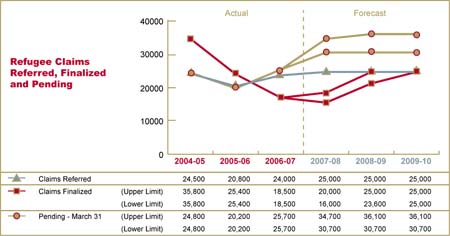
(Click on image to enlarge)
2007-2008 Outlook
The uncertainty surrounding appointments and reappointments of decision-makers to the RPD remained constant throughout fiscal year 2006-2007. As 2006 drew to a close, the RPD was short more than 40 decision-makers. As time progresses, decision-makers continue to reach the end of their mandates thus increasing the overall shortfall of decision-makers. New appointments or reappointments must be sufficient enough in number to both make up for the already established deficit of decision-makers, and the ongoing loss of decision-makers, which continues to accrue on a monthly basis.
Because of the uncertainty surrounding the appointments and reappointments of decision-makers to the RPD, a range of finalizations for 2007-2008 is projected. The lower limit of the range assumes that the IRB does not reach its full member complement over the fiscal year; instead half of the members required by end of fiscal year 2006-2007 are appointed to the RPD during 2007-2008. The upper limit of the range is based on the assumption that a full complement of decision-makers is received as of 1 April 2007. Both allow some time for new appointments to acquire the productivity of a seasoned member.
For fiscal year 2007-2008, the Refugee Protection Division expects that it will receive approximately 25,000 new claims, 4 per cent more than in fiscal year 2006-2007. It is expected that 2007-2008 will be marked by an increase in refugee claims from Mexico and claimants deemed eligible to file land border claims through the Canada-U.S. Safe Third Country Agreement.
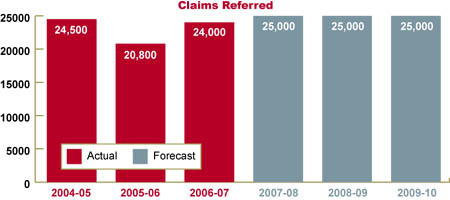
In 2007-2008, the Refugee Protection Division expects to finalize between 16,000 and 20,000 cases. The upper limit of 20,000 cases is 8 per cent more than in fiscal year 2006-2007. The projected increase in finalizations anticipates the appointment of decision-makers.
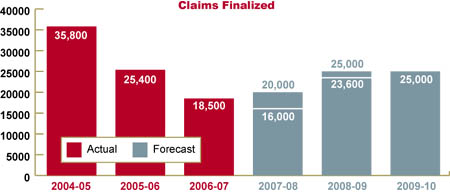
Based on 16,000 claim finalizations, the average cost per claim is expected to be $4,700 for 2007-2008; based on 20,000 claim finalizations, the average cost per claim is expected to be $3,900 for 2007-2008. These average costs per claim are higher than the 2005-2006 actual average cost of $3,175 per claim. In 2005-2006, there were 25,400 claims finalized. The increase in average costs for 2007-2008 is mainly attributable to a higher share of fixed costs per unit caused by a drop in volume under both volume finalizations scenarios as well as some salary increases.
The cost per claim includes the decision-making costs and costs of related activities such as case preparation, research, scheduling of hearings, legal services, foreign-language interpretation, technological support, translation services, and administrative support. It also includes a share of the costs from the Corporate Management and Services program activity, which is allocated to the three decision-making program activities, based on expenditure trends.
Due to the increase in the number of claims referred and the low level of finalizations in 2006-2007, some of the successes in reducing the inventory of claims pending accomplished in 2005-2006 and previous years have been lost. Because it is projected that referrals will again surpass finalizations in 2007-2008, the pending inventory could climb to as high as approximately 34,700 claims by the end of the 2007-2008 fiscal year. Further resources may be required in future years to lead to any significant reduction in the pending inventory.
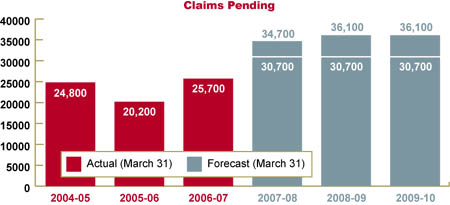
If the projected inventory grows, the average processing time could increase to 13.5 months by the end of 2007-2008.
Key Plans and Expected Results
To achieve its forecasts for fiscal year 2007-2008, and in line with the strategic priorities set out for the organization, the Refugee Protection program activity will undertake the planned activities with the expected results outlined in the following table.
Program Activity: Refugee Protection
Plans and Expected Results for 2007-2008
| Strategic Outcome: Provide Canadians with well-reasoned decisions on immigration and refugee matters efficiently, fairly and in accordance with the law. | |
| STRATEGIC PRIORITY 3 Continue to improve adjudicative and case management strategies including the implementation of Stage 1 of the ICMS. |
|
| Plans | Expected Results |
| Mitigate increasing pending inventory, processing times and cost per claim by monitoring and expanding the Fast Track initiative, reducing adjournments and postponements, and through a more sophisticated streamlining |
|
| Further monitoring of RPD Action Plan in order to ensure implementation |
|
| Pursue measures to further streamline RPD processes |
|
| Continue to implement and monitor the strategic approach to quality adjudicative support and decision-making through quality issue sessions, discussion groups, additional National Documentation Packages, Jurisprudential Guides and Persuasive Decisions, as needed, and Guidelines for Vulnerable Persons |
|
| Launch ICMS Stage 1 for RPD |
|
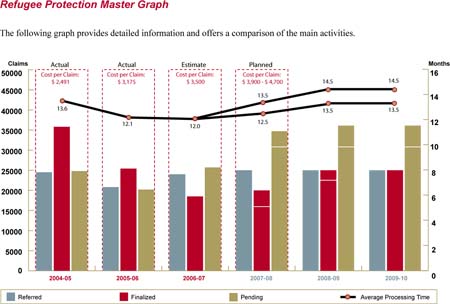
(Click on image to enlarge)
Admissibility Hearings and Detention Reviews Program Activity
The Immigration Division delivers the IRB's Admissibility Hearings and Detention Reviews program activity. Admissibility hearings are held for foreign nationals or permanent residents who are alleged to be inadmissible to Canada pursuant to the provisions of IRPA. Detention reviews are held for permanent residents and foreign nationals detained under IRPA authority, and must be conducted within specific timeframes set out in IRPA. Decision-makers must balance the rights of individuals to liberty with the security interests of Canadians and persons in Canada. The number of admissibility hearings and detention reviews conducted by the IRB depends on the number of cases referred to it by the CBSA and CIC.
| Financial Resources ($ millions) | ||
| 2007-2008 | 2008-2009 | 2009-2010 |
| 15.2 | 15.2 | 15.2 |
| Human Resources (Full-time Equivalents) | ||
| 2007-2008 | 2008-2009 | 2009-2010 |
| 90 | 90 | 90 |
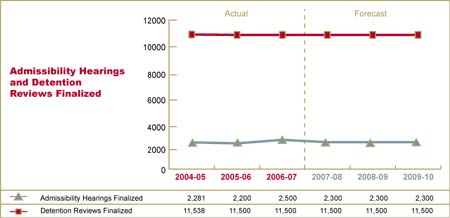
(Click on image to enlarge)
2007-2008 Outlook
The number of referrals for admissibility hearings has remained stable over the past three years. The Immigration Division expects to finalize 2,300 admissibility hearings in 2007-2008, a decrease of 8 per cent from the estimated 2006-2007 finalizations. The Division also forecasts that it will finalize 2,300 admissibility hearings in both 2008-2009 and 2009-2010.
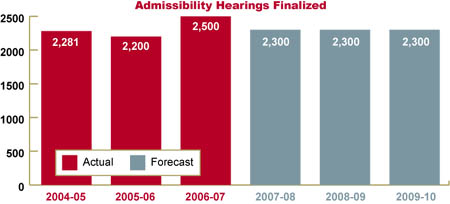
The number of detention reviews has also remained stable. The Division anticipates that it will finalize approximately 11,500 detention reviews in 2007-2008 and in the following two fiscal years. Ongoing challenges include the pressure associated with meeting statutory timeframes, travelling to detention facilities to conduct reviews and increased public scrutiny in balancing the rights to liberty of individuals with the security of Canadians and persons in Canada. Criminality, an important factor in detention reviews, is an element that is present in a high proportion of cases, particularly those that involve long-term detention.
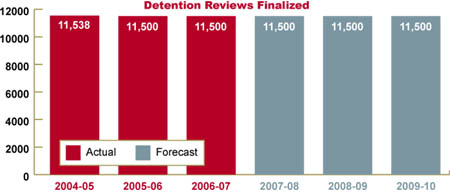
Based on 2,300 admissibility hearings and 11,500 detention reviews, the average cost is expected to be $1,100 and $800 respectively for 2007-2008. These average costs are slightly higher than the 2005-2006 actual average costs of $1,015 per admissibility hearing finalized and $710 per detention review finalized due mainly to increases in salary wages and increased translation costs.
The cost per admissibility hearing and detention review includes decision-making costs and costs of related activities such as case preparation, scheduling of hearings, legal services, foreign-language interpretation, technological support, translation services, as well as administrative support. It also includes a share of the costs from the Corporate Management and Services program activity, which is allocated to the three decision-making program activities, based on expenditure trends.
Key Plans and Expected Results
To achieve its forecasts for fiscal year 2007-2008, and in line with the strategic priorities set out for the organization, the Admissibility Hearings and Detention Reviews program activity will undertake the planned activities with the expected results outlined in the following table.
Program Activity: Admissibility Hearings
and Detention Reviews
Plans and Expected Results for 2007-2008
| Strategic Outcome: Provide Canadians with well-reasoned, timely decisions on immigration and refugee matters efficiently, fairly and in accordance with the law. | |
| STRATEGIC PRIORITY 2 Continue to build an organization that strengthens its operational and leadership capacity, its diversity and its flexibility. |
|
| Plans | Expected Results |
| Pursue succession recruitment efforts and integration of new members |
|
| STRATEGIC PRIORITY 3 Continue to improve adjudicative and case management strategies including the implementation of Stage 1 of the ICMS. |
|
| Plans | Expected Results |
| Introduce and implement innovative approaches to processes by further developing and promoting tools that will support quality, consistency and efficiency in decision-making |
|
| Develop harmonized processes and adopt a more flexible resource management approach to help meet the legislative timeframes and operational requirements to achieve finalization of all cases referred to the Division in a timely fashion |
|
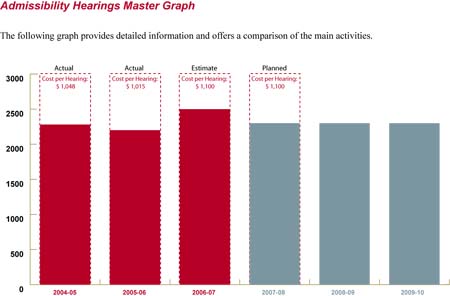
(Click on image to enlarge)
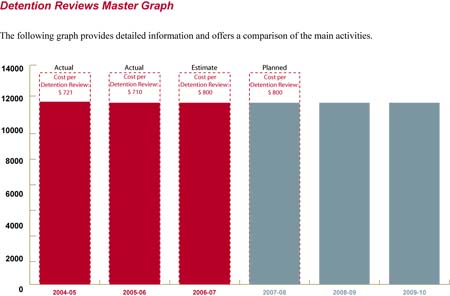
(Click on image to enlarge)
Immigration Appeal Program Activity
The Immigration Appeal Division delivers the IRB's Immigration Appeal program activity. It hears immigration appeals from Canadian citizens and permanent residents whose applications to sponsor close family members to Canada have been refused. Other key functions include hearing appeals from permanent residents, foreign nationals with a permanent resident visa, and protected persons who have been ordered removed from Canada, as well as from permanent residents outside of Canada who have not fulfilled their residency obligation.
| Financial Resources ($ millions) | ||
| 2007-2008 | 2008-2009 | 2009-2010 |
| 13.0 | 13.0 | 13.0 |
| Human Resources (Full-time Equivalents) | ||
| 2007-2008 | 2008-2009 | 2009-2010 |
| 120 | 120 | 120 |
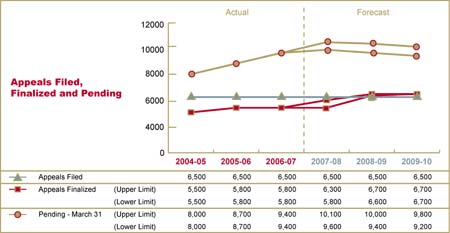
(Click on image to enlarge)
2007-2008 Outlook
The uncertainty surrounding appointments and reappointments of decision-makers to the IAD remained constant throughout fiscal year 2006-2007. As 2006 drew to a close, the IAD was short more than one-third of its decision-makers. As time progresses, decision-makers continue to reach the end of their mandates thus increasing the overall shortfall of decision-makers. New appointments or reappointments must be sufficient enough in number, and made on a timely basis, to make up for the ongoing shortfall of decision-makers.
Because of the uncertainty surrounding the appointments and reappointments of decision-makers to the IAD, a range of finalizations for 2007-2008 is projected. The lower limit of the range assumes that the IRB does not acquire its full member complement over the fiscal year; instead the IAD will increase by only half of its new member complement over the course of 2007-2008. The upper limit of the range is based on the assumption that the IAD receives a full complement of decision-makers by the end of the fiscal year 2006-2007, through a combination of reappointments and new appointments. Both the upper and lower limits of the range provide some time for new appointments to meet the potential of a fully productive member.
In fiscal year 2007-2008, the IAD anticipates 6,500 appeals to be filed, which is a volume consistent with the number of appeals received over the last three years. This level of intake is expected to continue in 2008-2009 and 2009-2010. Sponsorship appeals are expected to continue to make up an increasing proportion of appeals filed.
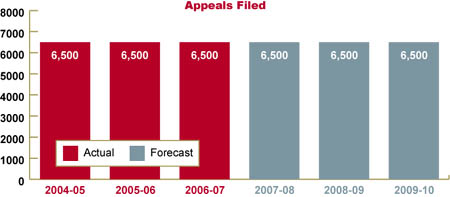
In 2007-2008, the Immigration Appeal Division expects to finalize between 5,800 and 6,300 appeals. The upper limit of 6,300 appeals is 9 per cent more than in fiscal year 2006-2007. The projected increase in finalizations anticipates the reappointment and appointment of decision-makers in accordance with the assumptions outlined above.
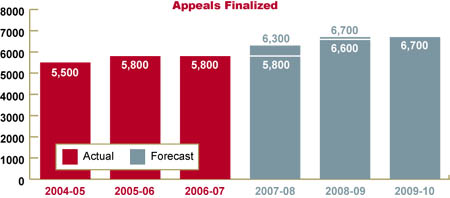
Based on 5,800 appeal finalizations, the average cost per appeal is expected to be $2,300 for 2007-2008; based on 6,300 appeal finalizations, the average cost per appeal is expected to be $2,200 for 2007-2008. These average costs per appeal are higher than the 2005-2006 actual average cost of $1,865 per appeal due mainly to a higher share of fixed costs per unit caused by a drop in volume under both volume finalization scenarios, some salary increases and higher translation costs. The cost per unit is increase when the Board operates below capacity due to being significantly short of its full member complement.
The cost per appeal includes the decision-making costs and costs of related activities such as case preparation, research, scheduling of hearings, legal services, foreign-language interpretation, technological support, translation services, as well as administrative support. It also includes a share of the costs from the Corporate Management and Services program activity, which is allocated to the three decision-making program activities, based on expenditure trends.
The pending inventory is expected to continue to grow in the short term, resulting in 9,600 to 10,100 appeals waiting for a decision by the end of fiscal year 2007-2008.
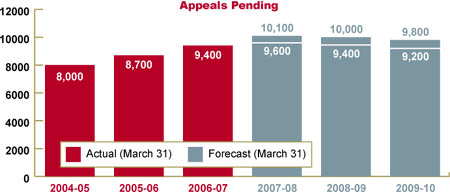
The average processing time is expected to increase to approximately 11.0 months in 2007-2008.
Key Plans and Expected Results
To achieve its forecasts for fiscal year 2007-2008, and in line with the strategic priorities set out for the organization, the Immigration Appeal program activity will undertake the planned activities with the expected results outlined in the table below.
Program Activity: Immigration Appeal
Plans and Expected Results for 2007-2008
| Strategic Outcome: Provide Canadians with well-reasoned, timely decisions on immigration and refugee matters efficiently, fairly and in accordance with the law. | |
| STRATEGIC PRIORITY 3 Continue to improve adjudicative and case management strategies including the implementation of Stage 1 of the ICMS. |
|
| Plans | Expected Results |
| IAD Innovation – Continued implementation of IAD Innovation proposals to transform IAD into a more flexible and proactive division |
|
| Early Information Gathering and Early Informal Resolution – Obtain more information from both parties earlier, to support earlier screening, streaming and resolution |
|
| Alternative dispute resolution (ADR) – Finish transition of ADR program to Public Service, and increase early informal resolution through successful ADR by public servants |
|
| Hearings – Ensure files are hearing-ready and have hearings conducted in a more proactive manner |
|
| Adjudication strategy and consistency – Develop and promote consistent and strategic approaches, including in areas such as removal order appeals and stays, proactive hearings, adjournments and postponements, and the applicant's testimony in marriage sponsorship appeals |
|
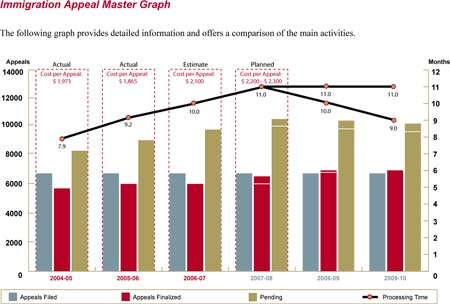
(Click on image to enlarge)
